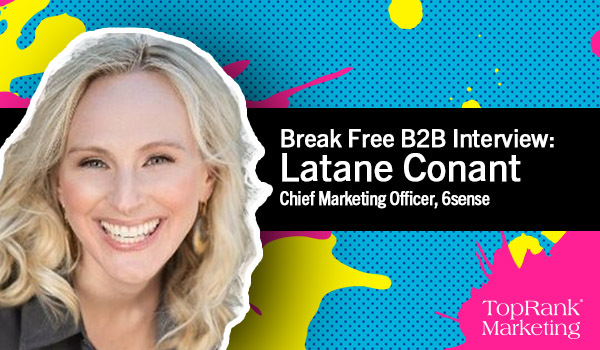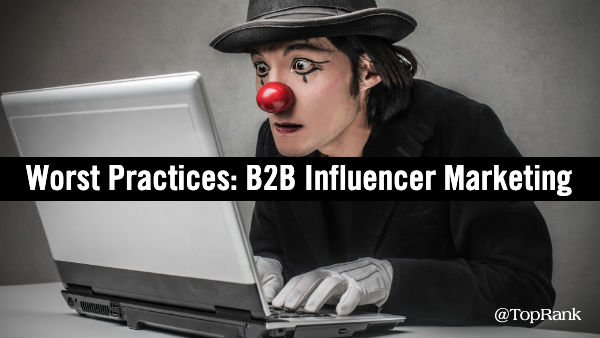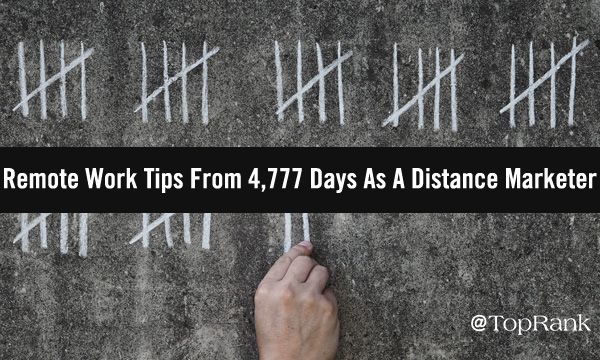

Today is day 4,777. Not days quarantined, but days working remotely. On Monday, March 23, 2007 I started working remotely, and 4,777 days later I still do. A staple aspect of my daily work life that had been the exception for most marketers is now — at least temporarily — the rule, with most people working from home due to the global health crisis. Having been a remote worker for a long time, I wanted to share the helpful practices that I wish I’d known when first starting out, and expand on my previous article “
Remote Communication Opportunities For B2B Marketers.” Many have been working remotely much longer than me, and each one will have their own stories of remote work successes and snafus. According to my “days-since” calculator, my 4,777 days of remote work has been comprised of:
- 412,732,800 seconds
- 6,878,880 minutes
- 114,648 hours
- 4777 days
- 682 weeks and 3 days
- 13.08 years
That’s a lot of remote work time, yet for me I wouldn’t want it any other way, as I’ve found that the many advantages of working remotely outnumber those of traditional business office work settings.
Remote Work Has Changed Forever
How cataclysmic have the changes brought about by the pandemic collectively affected perceptions surrounding remote work, and what lasting changes will forever alter how — and especially where — we work? Survey data has begun to show that people are increasingly seeing remote work as being at least as efficient and in some cases even more effective than traditional pre-pandemic office-based work. 65 percent of B2B decision makers now view their new work model as being as effective or more effective than pre-pandemic models, an increase of 5 percent over just one month, as shown in the following chart from
McKinsey.
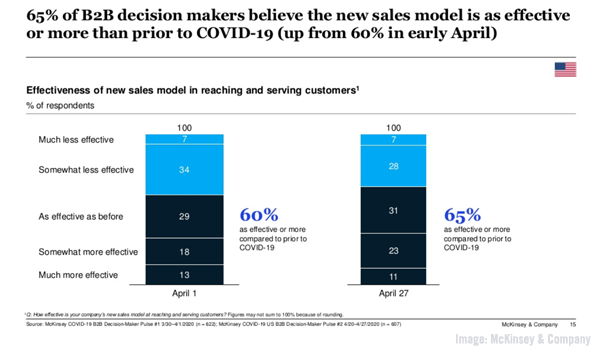
Even with dismal unemployment rates, new remote work job opportunities have begun to expand, as
Entrepreneur recently explored in “
These 50 Companies Are Growing and Hiring Remotely Right Now.” Let’s take a look at five helpful practices I’ve learned during my 13-plus year stint of remote work, including a third option that sits squarely between traditional work-spaces and the work-from-home model.
1 — Create Your Own Separate & Pleasant Physical Workspace
It's helpful to create your own separate physical workspace that's both pleasant and conductive to productive remote work. Whether it’s a dedicated room in your home where you’ll be doing the bulk of your work, a makeshift office set up in a garage or attic space, or a co-working space in another location, having a physical place — no matter how small — that you can leave at the end of the workday is a helpful way to separate your personal and professional life. When it comes to where you physically work, another option to consider is leasing your own private office space. This can be an ideal way to work remotely while also keeping home life separated from business, although depending on your location office space can be expensive. I’m lucky enough to live in a city with inexpensive office space where I’ve kept a private office for over 13 years, and I highly recommend this approach when possible. It combines most of the advantages of traditional offices in a corporate environment with the benefits of working remotely.
2 — Implement and Stick To a Firm Schedule
I’ve always found it helpful to build a regular schedule into each remote workday, starting and ending at predetermined times as much as possible. At the other end of the remote work spectrum are situations where you can take advantage of the flexibility of certain remote schedules, and work as needed throughout each 24-hour period. This will depend on your particular company, duties, and the value you place on either regular work hours or the freedom of work-time flexibility. Whichever method you choose, during that first year of remote work it’s helpful to devise your own personalized schedule that pulls in some of the best elements from your previous office location in order to bring a sense of familiarity and organization to your new working environment.
3 — Gain Energy By Embracing Remote Work’s Advantages
Although they may be difficult to find early on while you’re adjusting to remote work, it can be helpful to take the time to learn and savor the advantages of working remotely, especially for those working from a home office. Particularly if your remote work situation isn’t a permanent one, it's beneficial to take the time to appreciate the little things that working remotely provides — whether it’s sharing a lunch with your partner or children, taking a break-time walk in a new nearby area, or simply enjoying some extra time you’ve saved by not having to contend with a lengthy work commute. Once stay-at-home safety measures are a thing of the past, another advantage of remote work to explore will be the ability to work from a variety of locations, which can help keep your B2B marketing work fresh and provide extra energy as you bring your laptop office to different spots in your city — an eventually as the pandemic subsides — state, country, and internationally. Remote work situations will likely become permanent for many in the months and years ago, while a variety of hybrid scenarios may also proliferate, such as splitting the work-week between remote and time at the company office.
3 — Creatively Insulate Yourself From Distraction
Just as in a traditional office environment, it’s smart to minimize distractions as much as possible, so that you can use remote work to find a newfound focus on your projects. If working from home, be sure the people in your home know your working schedule, and encourage them to connect with you only during set times such as over lunch or breaks. Some remote workers like to get outside when possible, especially if distractions threaten to interfere with important meetings or projects. Other remote workers chose to wear noise-cancelling headphones or to listen to music while working if noisy distractions are otherwise unavoidable.
4 — Utilize Powerful Remote Collaboration Software
During
the Internet’s amazing 50-year history we’ve never had such powerful remote collaboration software available as we do now, and during the pandemic more people than ever have learned to use tools such as Zoom and Slack. Marketers typically use a vast number of tools daily, and thankfully nearly all can be used successfully in remote work settings, as our senior operations strategist
Anne Leuman recently explored in “
5 Examples of Effective B2B Content Marketing in Times of Crisis,” also showing how marketers are adjusting messaging during the pandemic. Offering a complete remote work operating system, our client monday.com has been sharing the fascinating stories of how its team has been finding success during the pandemic in
a series of team member portraits called #MyRemoteLife, and publishing helpful information such as “
19 WFH Stats That Might Surprise You.” Whatever tools you work with, in a remote work setting it’s just as important as in a traditional office environment to make sure that all your hardware and software are fully set up and ready for marketing action.
5 — Implement Remote-Friendly Tech Gadgets
As with a traditional business office, remote workers should set up the technology hardware necessary for doing your best work, whether it’s a second, third, or fourth monitor, or a WiFi signal extender. The size and number of monitors you work with is a personal preference, and may be limited by your laptop or desktop’s graphic cards. For me, I found the jump in productivity of going from two monitors to three was much more noticeable than the move long ago from one to two. I first worked with a multiple-monitor setup all the way back in the 1980s, when I used three monitors in a multiple Commodore Amiga computer system.

Technology and marketing have both changed significantly during the intervening years, yet thankfully much also still remains the same, such as
the importance of trust in marketing and
the power of telling a good story.
Get Closer To Your Projects Than Ever Through Remote Work
A properly set up remote work environment can provide a positive and distraction-free place to focus intensely on your projects, and research continues to emerge showing that this is a very real advantage of working outside of a traditional office environment. Every successful remote worker has their own favorite productivity and well-being tips, and our team at TopRank Marketing has penned the following recent remote work articles offering additional insight:
There’s never been a better time to tackle remote work, and the challenges and opportunities created by a workforce that will likely continue to make this switch in numbers the world has never seen, will combine to make this an era unlike any other. As B2B marketers, even if we continue to work from the traditional office building, we’ll be working with a new era of clients, associates, and business partners featuring more remote workers than ever — a grand experiment with outcomes and possibly unforeseen consequences. Looking for help with your B2B marketing?
Contact us today and find out why clients such as LinkedIn, Adobe, Dell, 3M, Slack, and Oracle have chosen TopRank Marketing, and connect with us on
LinkedIn,
Twitter,
Facebook,
Instagram and our
YouTube channel.

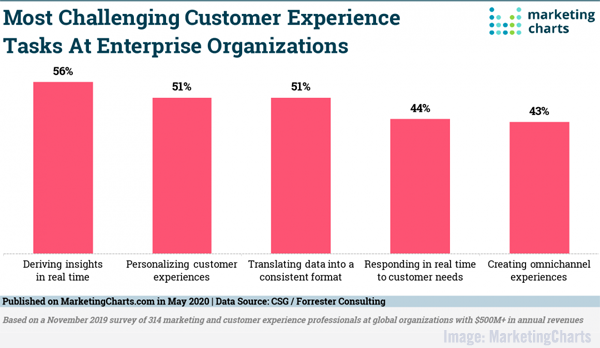
 What B2B Buyers Want From Tech Vendors Right Now 55 percent of B2B buyers say it's appropriate for marketing efforts to continue during these challenging times, and 53 percent are presently in the market for B2B products and services, with most of those having recent new purchasing interests, according to newly-released survey data. MarketingProfs Programmatic Ad Spend Down 9% Since Beginning of 2020, Driven by Travel and Auto Amidst an overall fall of 9 percent in April, ad spending for the technology vertical and the education and training segment were up 70 percent and 63 percent for the year, with streaming ad spend also up by some 18 percent, according to recently-released report data. Adweek Exclusive: New York Times phasing out all 3rd-party advertising data The New York Times has begun eliminating all third-party advertising targeting information, and by July the firm will instead use a fully-proprietary platform, the company recently announced. Axios Google’s digital-ad dominance is harming marketers and publishers, says new study Digital marketers and publishers have been hurt as a result of Google's online advertising dominance, according to a new study, with display ads the primary focus of the Omidyar Network and Public Knowledge report. AdAge Reddit Launches New, 12-Week Online Advertising School Program Social news and discussion platform Reddit has launched a three-month online community-driven advertising school program, led by director-level-or-above instructors covering 12 marketing topics, the firm recently announced. Social Media Today Polls Return to Messenger From Facebook. After a year’s absence Facebook Messenger polls have been brought back Digital marketers lamenting the elimination of Facebook's Messenger polls a year ago got good news recently, as the social media giant announced that it has brought the polling option back for group chats. Adweek
What B2B Buyers Want From Tech Vendors Right Now 55 percent of B2B buyers say it's appropriate for marketing efforts to continue during these challenging times, and 53 percent are presently in the market for B2B products and services, with most of those having recent new purchasing interests, according to newly-released survey data. MarketingProfs Programmatic Ad Spend Down 9% Since Beginning of 2020, Driven by Travel and Auto Amidst an overall fall of 9 percent in April, ad spending for the technology vertical and the education and training segment were up 70 percent and 63 percent for the year, with streaming ad spend also up by some 18 percent, according to recently-released report data. Adweek Exclusive: New York Times phasing out all 3rd-party advertising data The New York Times has begun eliminating all third-party advertising targeting information, and by July the firm will instead use a fully-proprietary platform, the company recently announced. Axios Google’s digital-ad dominance is harming marketers and publishers, says new study Digital marketers and publishers have been hurt as a result of Google's online advertising dominance, according to a new study, with display ads the primary focus of the Omidyar Network and Public Knowledge report. AdAge Reddit Launches New, 12-Week Online Advertising School Program Social news and discussion platform Reddit has launched a three-month online community-driven advertising school program, led by director-level-or-above instructors covering 12 marketing topics, the firm recently announced. Social Media Today Polls Return to Messenger From Facebook. After a year’s absence Facebook Messenger polls have been brought back Digital marketers lamenting the elimination of Facebook's Messenger polls a year ago got good news recently, as the social media giant announced that it has brought the polling option back for group chats. Adweek 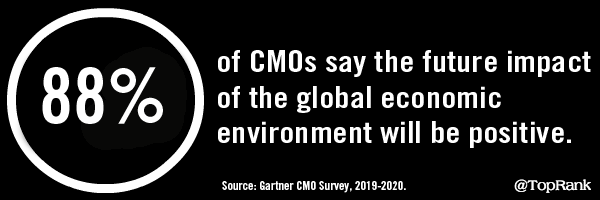 Pandemic hastens shift in ad buying to mobile, study says During an overall drop in ad spending, mobile ad spend has fared the best, as its 15 percent decrease was less than the 25 percent seen for desktop ad buying, according to recently-released study data. Mobile Marketer Facebook Launches New App Called 'CatchUp' to Facilitate Group Phone Chats Facebook recently released a tool to help bring online conversations to real-time phone communications, with the lanch of CatchUp, becomming Facebook’s sixth new app release in the past half year, the firm announced. Social Media Today Enterprise Companies Struggle with Customer Experience Tasks Real-time insights, personalization, and consistent data formatting are the top three customer experience (CX) challenges for enterprise firms, according to recently-released study data. MarketingCharts LinkedIn Publishes New Guide to Key Content Trends Amid COVID-19 LinkedIn (client) has released new information about trending content on the Microsoft-owned platform, with top trending hashtags and other information of interest to digital marketers, the firm announced. Social Media Today ON THE LIGHTER SIDE:
Pandemic hastens shift in ad buying to mobile, study says During an overall drop in ad spending, mobile ad spend has fared the best, as its 15 percent decrease was less than the 25 percent seen for desktop ad buying, according to recently-released study data. Mobile Marketer Facebook Launches New App Called 'CatchUp' to Facilitate Group Phone Chats Facebook recently released a tool to help bring online conversations to real-time phone communications, with the lanch of CatchUp, becomming Facebook’s sixth new app release in the past half year, the firm announced. Social Media Today Enterprise Companies Struggle with Customer Experience Tasks Real-time insights, personalization, and consistent data formatting are the top three customer experience (CX) challenges for enterprise firms, according to recently-released study data. MarketingCharts LinkedIn Publishes New Guide to Key Content Trends Amid COVID-19 LinkedIn (client) has released new information about trending content on the Microsoft-owned platform, with top trending hashtags and other information of interest to digital marketers, the firm announced. Social Media Today ON THE LIGHTER SIDE: 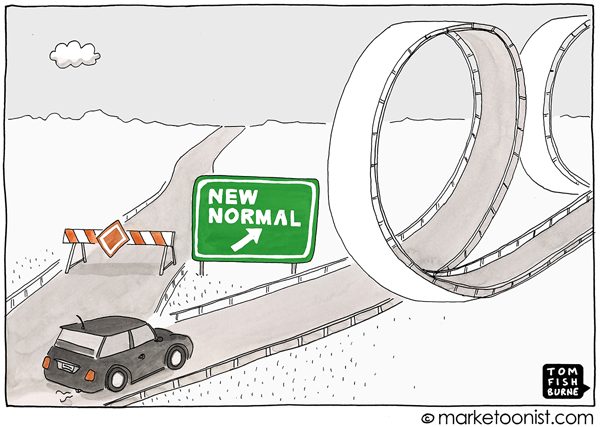 A lighthearted look at “the new normal” by Marketoonist Tom Fishburne — Marketoonist Whoooaaa Duuuuude: Why We Stretch Words in Tweets and Texts — Wired TOPRANK MARKETING & CLIENTS IN THE NEWS:
A lighthearted look at “the new normal” by Marketoonist Tom Fishburne — Marketoonist Whoooaaa Duuuuude: Why We Stretch Words in Tweets and Texts — Wired TOPRANK MARKETING & CLIENTS IN THE NEWS:
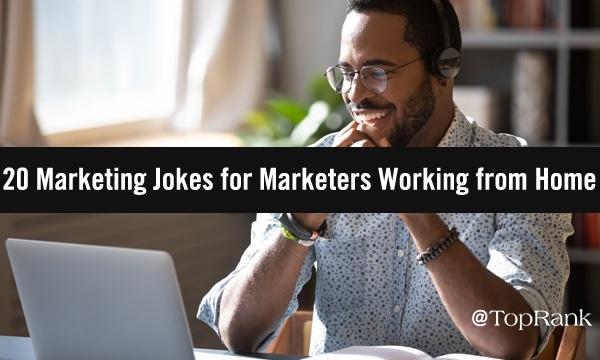
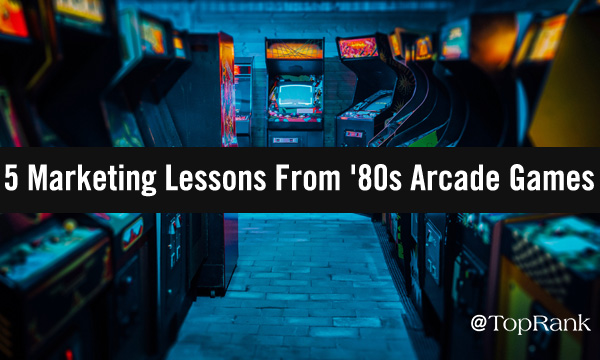
 Photo by Author[/caption] Williams Electronics’ Defender is my all-time favorite stand-up video arcade game, an insidiously difficult side-scrolling spaceship-protecting-the-world shooting match juggernaut from 1981 programmed by early video game legend Eugene Jarvis. I played Defender so much that I eventually won a local video game competition, and can still almost feel where I had callouses on my hands from hour upon hour of game-play long ago. Defender teaches marketers the importance of
Photo by Author[/caption] Williams Electronics’ Defender is my all-time favorite stand-up video arcade game, an insidiously difficult side-scrolling spaceship-protecting-the-world shooting match juggernaut from 1981 programmed by early video game legend Eugene Jarvis. I played Defender so much that I eventually won a local video game competition, and can still almost feel where I had callouses on my hands from hour upon hour of game-play long ago. Defender teaches marketers the importance of 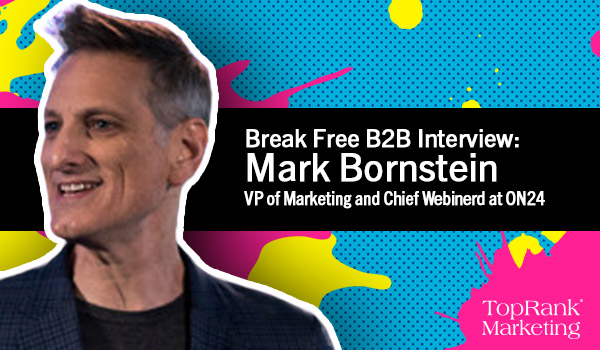
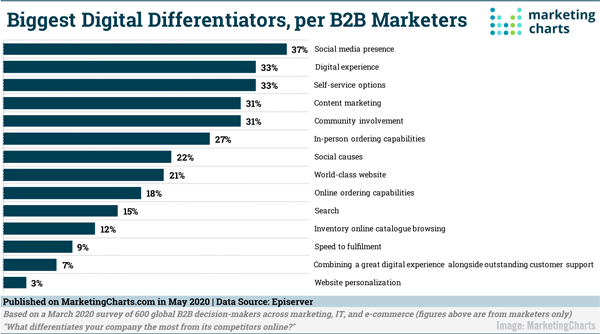
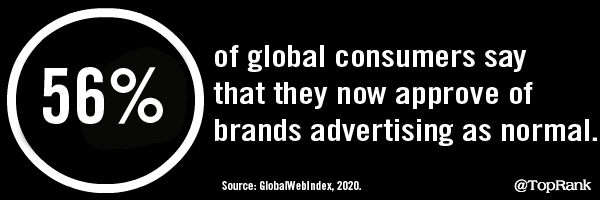 Facebook's 'Messenger Rooms' Multi-Participant Video Chat Option is Now Available to All Facebook has launched its Messenger Rooms video messaging feature with a global release that includes up to 50 video participants and the ability to drop in via Facebook’s feed, the firm recently announced.
Facebook's 'Messenger Rooms' Multi-Participant Video Chat Option is Now Available to All Facebook has launched its Messenger Rooms video messaging feature with a global release that includes up to 50 video participants and the ability to drop in via Facebook’s feed, the firm recently announced. 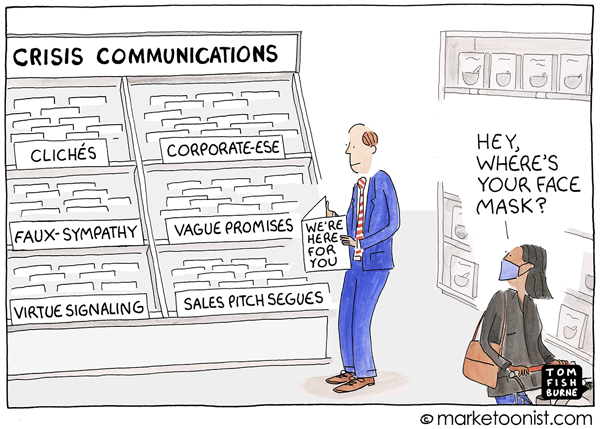 A lighthearted look at “communicating in a crisis” by Marketoonist Tom Fishburne —
A lighthearted look at “communicating in a crisis” by Marketoonist Tom Fishburne — 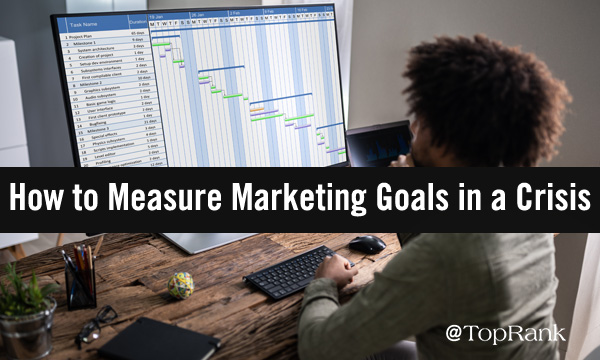

 Even with dismal unemployment rates, new remote work job opportunities have begun to expand, as Entrepreneur recently explored in “
Even with dismal unemployment rates, new remote work job opportunities have begun to expand, as Entrepreneur recently explored in “ Technology and marketing have both changed significantly during the intervening years, yet thankfully much also still remains the same, such as
Technology and marketing have both changed significantly during the intervening years, yet thankfully much also still remains the same, such as 